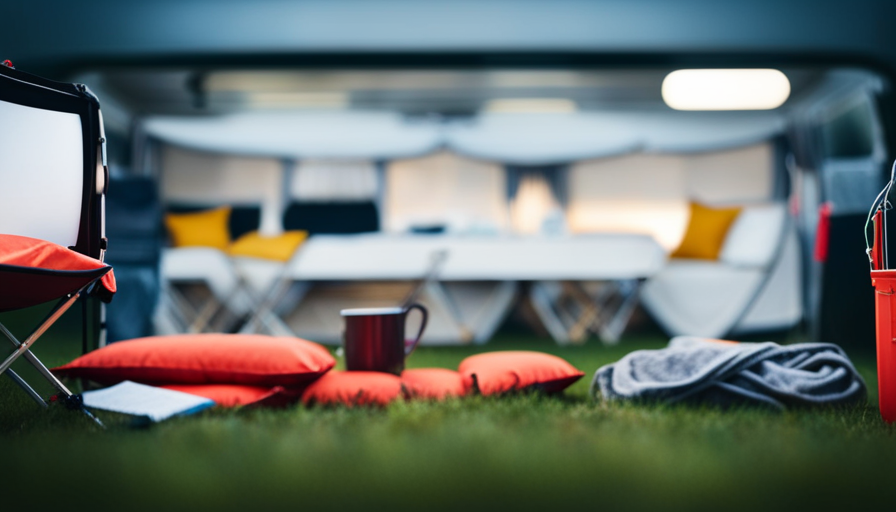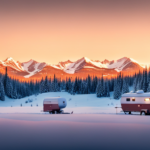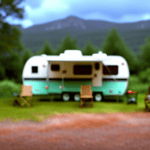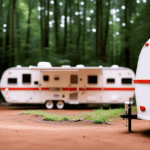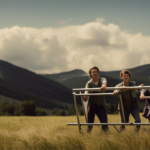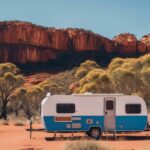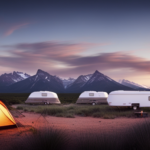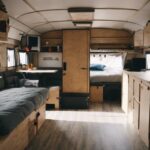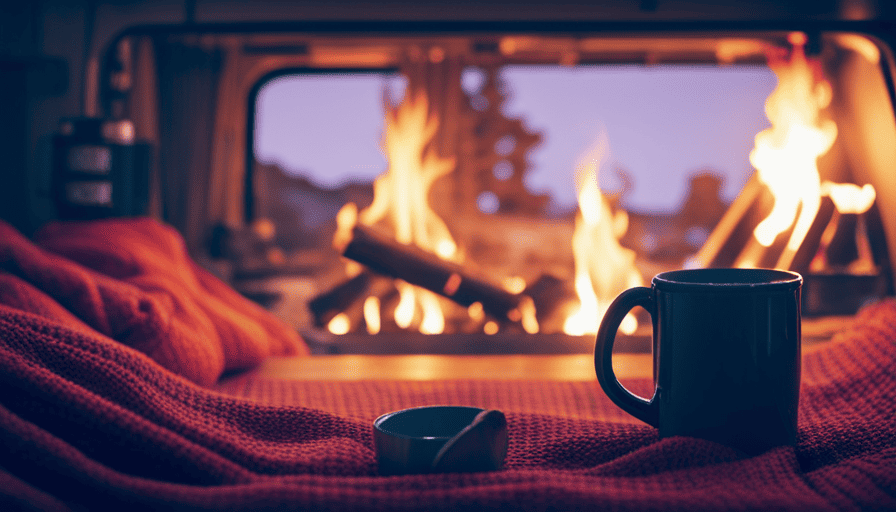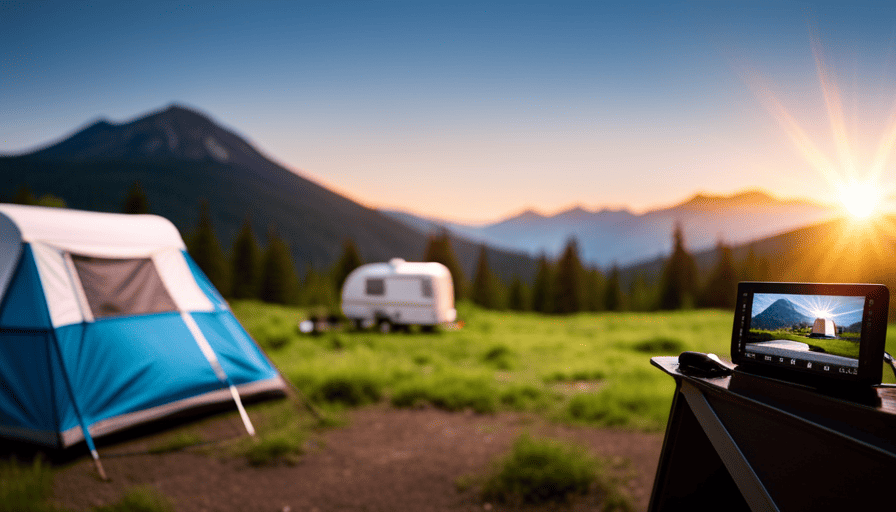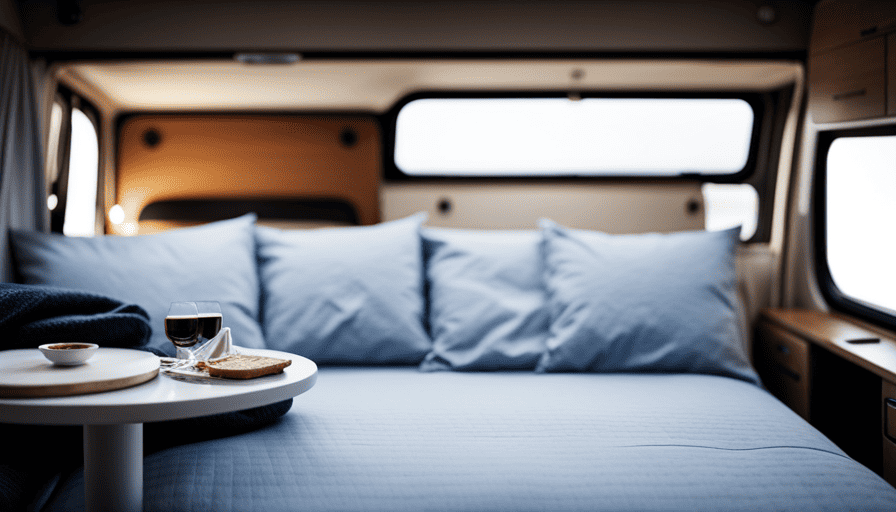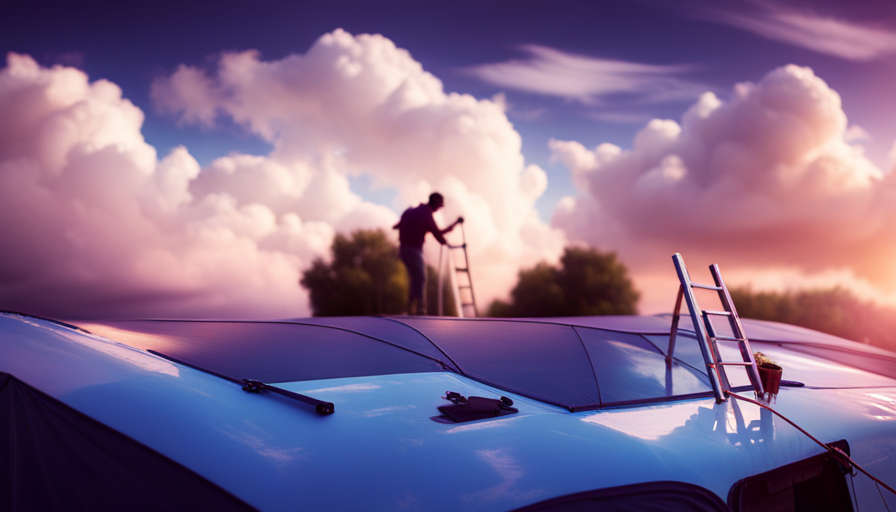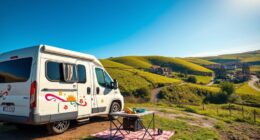By chance, my significant other and I recently started looking for a camper trailer. Camping has always been something we loved, but now we were prepared to upgrade our outdoor experiences with more ease and comfort. Yet, when we initiated our search, it became apparent that picking the suitable camper trailer was a challenging endeavor. There appeared to be limitless choices, and it was clear we had to gather ample knowledge to ensure we made the most informed decision.
That’s when we decided to compile a comprehensive guide on what to look for in a camper trailer. In this article, we will share our knowledge and experience to help you make an informed choice. From determining your camping needs and preferences to evaluating the size, weight, and sleeping capacity, we will cover all the essential factors to consider.
So, let’s dive in and find the perfect camper trailer for your outdoor adventures!
Key Takeaways
- Determine your camping needs and preferences, considering factors such as climate, number of people camping, and desired comfort level.
- Look for a camper trailer that offers a balance between comfort and practicality, with features such as comfortable sleeping and seating options, functional kitchen and bathroom facilities, and ample storage space.
- Evaluate the construction quality, towing capacity, and maneuverability features of the camper trailer to ensure durability, safety, and a pleasant driving experience.
- Set a budget and compare prices from different brands and dealerships, considering long-term costs and value for money. Additionally, take a test drive and thoroughly inspect the camper trailer to ensure it meets your requirements and is in good condition.
Determine Your Camping Needs and Preferences
Before you start searching for a camper trailer, it’s crucial to determine your camping needs and preferences. This will help you narrow down your options and find a camper trailer that best suits your lifestyle. Consider factors such as the size of the trailer, amenities, and any specific features you may require. Additionally, it’s important to consider whether you’ll be camping in warmer or cooler climates, as this may impact the type of camper trailer you choose. Once you’ve found the perfect camper trailer and are ready to start using it, be sure to dewinterize your camper trailer before your first trip to ensure everything is in proper working order.
Camping in different climates is an important factor to consider. If you plan on camping in various locations with different weather conditions, you’ll want to ensure that the camper trailer you choose is suitable for all climates. Look for features such as insulated walls, a reliable heating and cooling system, and weather-resistant materials.
Another decision you’ll need to make is whether to choose a motorhome or a trailer. Motorhomes offer the convenience of having everything in one vehicle, including a living space and a driving area. They’re easier to maneuver and set up, making them a popular choice for those who prefer a hassle-free camping experience. On the other hand, trailers offer more flexibility as they can be detached from the towing vehicle, allowing you to explore the surrounding areas without bringing your entire living space with you.
Consider the size and weight of the trailer as well. A larger trailer may provide more living space, but it can be more difficult to tow and maneuver. Additionally, a heavier trailer may require a larger towing vehicle. Take into account your vehicle’s towing capacity and your comfort level with towing before making a decision.
Transitioning into the next section about considering the size and weight of the trailer, it’s important to find a balance between comfort and practicality when choosing a camper trailer.
Consider the Size and Weight of the Trailer
While considering the size and weight of a camper trailer, it’s important to keep in mind that finding the perfect fit is like finding a needle in a haystack. Size considerations play a crucial role in ensuring that the trailer meets your specific needs.
First, think about how many people will be camping with you. If it’s just you and a partner, a smaller trailer might suffice. However, if you plan on traveling with your family or a group of friends, you’ll need a larger trailer with enough space for everyone.
Additionally, consider the length and width of the trailer. Will it fit in your driveway or storage area? Will it be able to navigate through narrow roads or tight camping spots? These size considerations are essential for a smooth and enjoyable camping experience.
Weight limitations are another aspect to consider when choosing a camper trailer. Your vehicle’s towing capacity is crucial here. Make sure the trailer’s weight falls within the limits set by your vehicle’s manufacturer. Exceeding these limits can lead to safety hazards and potential damage to your vehicle.
It’s also important to consider the weight distribution within the trailer. Unevenly distributed weight can affect the trailer’s stability on the road.
Now that we’ve discussed the size and weight considerations, let’s move on to evaluating the sleeping and seating capacity of the camper trailer.
Evaluate the Sleeping and Seating Capacity
Considering the number of people you plan to camp with, it’s important to assess the sleeping and seating capacity of your chosen camper trailer.
When it comes to sleeping comfort, you’ll want to ensure that the trailer can accommodate everyone comfortably. Look for trailers that offer a variety of sleeping options, such as bunk beds, convertible sofas, and spacious queen-sized beds. This will ensure that everyone can get a good night’s sleep after a long day of outdoor adventures.
In addition to sleeping arrangements, it’s also crucial to evaluate the seating configurations of the camper trailer. Think about how you and your camping companions will spend your time inside the trailer. Look for comfortable seating options that can accommodate everyone during meals, game nights, or simply relaxing after a hike. Some trailers even offer versatile seating arrangements that can be adjusted to suit your needs.
As you consider the sleeping and seating capacity, keep in mind the space available in the trailer. It’s important to strike a balance between comfort and functionality. A trailer that is too cramped may lead to a less enjoyable camping experience. On the other hand, a trailer that is too spacious may be difficult to tow and maneuver. Finding the right balance will ensure that everyone can relax and enjoy their time in the camper trailer.
When evaluating the sleeping and seating capacity of a camper trailer, it’s essential to consider the needs and preferences of your camping group. Once you have determined the appropriate sleeping and seating arrangements, you can move on to looking for functional kitchen and bathroom facilities.
Look for Functional Kitchen and Bathroom Facilities
Make sure you have a functional kitchen and bathroom in your camper trailer to ensure you can easily prepare meals and have convenient facilities while on your camping adventure. Here are three key aspects to consider when looking for functional kitchen and bathroom facilities.
-
Space-saving design: Look for camper trailers that offer cleverly designed kitchens and bathrooms that maximize the available space. This includes foldable or retractable features, such as collapsible sinks and countertops, to provide ample room for food preparation and storage.
-
Energy-efficient appliances: Opt for camper trailers that come equipped with energy-efficient kitchen appliances, such as refrigerators and stoves. These appliances not only help conserve energy but also ensure that your food stays fresh and your cooking is efficient.
-
Ventilation and lighting options: Look for camper trailers that provide proper ventilation and lighting in the kitchen and bathroom areas. Good ventilation prevents the buildup of cooking odors and moisture, while adequate lighting ensures you can easily see and work in these spaces, even during nighttime.
In addition to these factors, consider other important aspects such as water storage and filtration systems, comfortable and ergonomic layout, easy-to-clean surfaces, durable and long-lasting materials, customizable and modular features, as well as safety features and certifications.
With a functional kitchen and bathroom in your camper trailer, you’ll have the convenience and comfort you need for a memorable camping experience. Now, let’s check the storage options and cargo capacity.
Check the Storage Options and Cargo Capacity
When it comes to your camping adventure, ensuring ample storage options and cargo capacity in your camper trailer is essential for a seamless and organized experience. Having efficient storage organization and cargo management can make a significant difference in how enjoyable your trip is.
A well-designed camper trailer should provide a variety of storage solutions to accommodate all your needs. Look for campers that have spacious cabinets, drawers, and closets to store your clothes, kitchenware, and other essentials. It’s also beneficial to have overhead compartments and under-bed storage, as they maximize the use of space. Additionally, consider trailers with external storage compartments for items like camping gear, tools, and outdoor equipment. These options ensure that everything is easily accessible and neatly stored.
Cargo capacity is another critical factor to consider. You want to make sure your camper trailer can handle the weight of your belongings without compromising its performance. Check the cargo weight rating provided by the manufacturer and ensure it meets your requirements.
Assessing the quality and durability of the construction is the next step in finding the perfect camper trailer. By evaluating the build materials, construction methods, and overall craftsmanship, you can determine if the trailer will withstand the demands of your camping adventures.
Assess the Quality and Durability of the Construction
When it comes to choosing a camper trailer, it’s important to consider all aspects of its design and construction. In our search for the perfect camper, we’ve already discussed the importance of storage options and cargo capacity. Now, let’s shift our focus to another crucial factor: assessing the quality and durability of the construction.
Evaluating the construction quality is essential to ensure that your camper trailer will withstand the rigors of the road and provide a safe and comfortable shelter. Here are three key aspects to consider:
-
Frame and chassis: A sturdy frame and chassis are essential for the overall stability and durability of the camper trailer. Look for materials like steel or aluminum that are known for their strength and resistance to corrosion.
-
Exterior materials: The exterior of the camper should be made from high-quality materials that can withstand harsh weather conditions and resist wear and tear. Fiberglass, aluminum, or composite panels are popular choices.
-
Interior finishes: Assess the quality of the interior finishes, such as cabinetry, flooring, and upholstery. Look for materials that aren’t just aesthetically pleasing but also durable and easy to clean.
By carefully assessing the construction quality and durability of a camper trailer, you can make a more informed decision and choose a vehicle that’ll stand the test of time and adventure.
Now, let’s move on to the next section where we’ll consider the towing and maneuverability features of camper trailers.
Consider the Towing and Maneuverability Features
Now imagine yourself effortlessly navigating winding roads and tight spaces with a camper trailer that boasts exceptional towing and maneuverability features. When considering a camper trailer, it’s crucial to assess the towing capacity and ease of maneuvering.
The towing capacity determines how much weight the trailer can safely handle, so it’s essential to match it with your vehicle’s capabilities. Additionally, ease of maneuvering is vital, especially when navigating through narrow roads or backing into tight camping spots. Look for features such as a shorter overall length, a streamlined design, and a responsive braking system to enhance maneuverability.
A camper trailer with a high towing capacity allows you to bring along all the essentials for your outdoor adventures without compromising safety. It ensures that you can tow your trailer without straining your vehicle’s engine and suspension. On the other hand, a trailer that’s easy to maneuver makes your camping experience more enjoyable and stress-free. It enables you to navigate through challenging terrains and tight spaces effortlessly.
As you consider the towing and maneuverability features of a camper trailer, also take the time to research the reputation and customer reviews of the brand. This step will provide valuable insights into the overall quality and reliability of the trailer, helping you make an informed decision.
Research the Reputation and Customer Reviews of the Brand
Before you make your decision, take a moment to dive into the world of customer reviews and reputation surrounding the brand, immersing yourself in the stories and experiences of fellow outdoor enthusiasts who’ve embarked on their own adventures with these trailers.
Researching customer feedback and brand reputation is crucial when considering a camper trailer. By doing so, you can gain valuable insights into the quality, durability, and overall satisfaction that previous customers have had with a particular brand.
Look for reviews that highlight the reliability of the trailer, the ease of setup and maintenance, and the level of customer support provided by the brand. Pay attention to any recurring issues or concerns raised by multiple customers, as this could be indicative of potential drawbacks or red flags.
A brand with a positive reputation and a track record of delivering quality products is more likely to provide you with a reliable and satisfying camper trailer experience. Positive customer reviews can give you confidence in your decision and help you avoid potential pitfalls.
Once you have thoroughly researched the reputation and customer reviews of the brand, you can move on to the next step of setting a budget and comparing prices.
Set a Budget and Compare Prices
To make an informed decision, it’s important to establish a budget and compare prices for different brands of camper trailers. Budget considerations play a crucial role in determining the right camper trailer for your needs. Here are some key factors to consider when setting your budget and comparing prices:
-
Determine your overall budget: Before diving into the world of camper trailers, it’s essential to have a clear understanding of how much you’re willing to spend. This will help narrow down your options and prevent overspending.
-
Research the market: Take the time to research different brands and models of camper trailers. Look for ones that align with your budget and offer the features you desire.
-
Compare prices: Once you have a list of potential camper trailers, compare their prices from different dealerships and online platforms. Don’t forget to factor in any additional costs such as taxes and registration fees.
-
Consider the long-term costs: While comparing prices, also consider the long-term costs associated with owning a camper trailer. These may include maintenance, insurance, and campground fees.
-
Look for value for money: Don’t just focus on the lowest price. Instead, consider the overall value for money. A slightly higher-priced camper trailer may offer better quality and durability, saving you money in the long run.
Setting a budget and comparing prices will help you find a camper trailer that fits your needs and wallet. Once you’ve narrowed down your options, it’s time to take a test drive and inspect the trailer in person to ensure it meets your expectations.
Take a Test Drive and Inspect the Trailer in Person
Hitting the road in a camper trailer is like embarking on a new adventure, and taking a test drive and inspecting the trailer in person is like test-driving a dream on wheels. When it comes to buying a camper trailer, it’s crucial to thoroughly inspect its condition before making a decision.
Start by checking the exterior for any signs of damage, such as dents or scratches. Make sure to examine the tires, brakes, and suspension system to ensure they’re in good working condition.
Inside the trailer, pay close attention to the overall cleanliness and functionality of the living space. Check the plumbing, electrical systems, and appliances to ensure they’re all functioning properly.
It’s also important to take the trailer for a test drive to get a feel for how it handles on the road. Pay attention to the steering, braking, and acceleration to ensure a smooth and comfortable driving experience.
Additionally, test out the living space to see if it meets your needs in terms of size, layout, and amenities.
By thoroughly inspecting and test driving the camper trailer, you can ensure that it’s in good condition and will provide you with an enjoyable travel experience.
Frequently Asked Questions
What are the best camper trailer brands currently on the market?
When it comes to the best camper trailer brands on the market, there are a few that stand out. From my experience, some top choices include Airstream, Jayco, and Forest River.
These brands offer a range of high-quality camper trailers with excellent features and durability. When choosing the right size camper trailer, it’s important to consider your needs and preferences. Don’t forget to invest in the best camper trailer accessories to enhance your camping experience.
Are there any specific safety features that I should look for in a camper trailer?
When it comes to camper trailers, safety should always be a top priority. Look for specific safety features like electronic stability control, anti-sway systems, and brake assist to ensure a smooth and secure ride.
Regular maintenance is also crucial for camper trailers. By keeping up with inspections, tire rotations, and brake checks, you can prevent accidents caused by wear and tear. Remember, a well-maintained camper trailer is a safe and reliable companion on your adventures.
Can you recommend any resources or websites where I can find detailed camper trailer reviews?
When it comes to choosing the right size camper trailer for your needs, there are a few factors to consider. Think about how many people will be using it, the amount of storage space you require, and the towing capacity of your vehicle.
As for finding affordable camper trailer rentals, there are several websites and resources available that provide detailed reviews and comparisons. Some popular options include RVshare, Outdoorsy, and CamperReport. These platforms offer a wide range of camper trailers to choose from, allowing you to find the perfect fit for your next adventure.
Is there a certain type of camper trailer that is better suited for off-road adventures?
For off-road adventures, it’s important to choose a camper trailer with excellent off-road capabilities. Look for features like rugged suspension, high ground clearance, and durable tires.
A sturdy frame and reinforced chassis are also crucial. Additionally, consider features like a robust braking system and off-road tires for added safety.
Remember, off-road camper trailers should be built to withstand the challenges of rough terrain, ensuring a smooth and enjoyable adventure.
Are there any additional costs or maintenance requirements that I should be aware of when owning a camper trailer?
Additional costs and maintenance requirements are important factors to consider when owning a camper trailer. While the initial purchase may seem like the biggest expense, it’s crucial to budget for ongoing expenses such as insurance, registration fees, and storage.
Regular maintenance, including servicing the engine, checking the tires, and inspecting the electrical system, is essential to ensure safe and reliable travels. Neglecting these responsibilities could lead to costly repairs or even jeopardize your camping adventures.
What Factors Should I Consider When Choosing a Camper Van?
When choosing a camper van, it’s crucial to consider some camper van essentials. First, evaluate its size and layout to ensure it accommodates your needs. Second, look into its features, such as a comfortable bed, kitchen facilities, and storage options. Additionally, consider the van’s fuel efficiency and maintenance costs to fit your budget.
Conclusion
In conclusion, when it comes to choosing a camper trailer, there are several factors to consider. We must determine our camping needs and preferences and evaluate the size and weight of the trailer. We should also assess the sleeping and seating capacity.
Additionally, it is important to look for functional kitchen and bathroom facilities and check the storage options and cargo capacity. We should also consider the towing and maneuverability features. Researching the reputation and customer reviews of the brand, setting a budget, and comparing prices are crucial steps.
Finally, taking a test drive and inspecting the trailer in person is essential. Did you know that according to a recent survey, 70% of camper trailer owners reported that the kitchen facilities were the most important feature they considered when making their purchase? So make sure you choose a camper trailer with a functional kitchen that meets your needs.
Happy camping!


